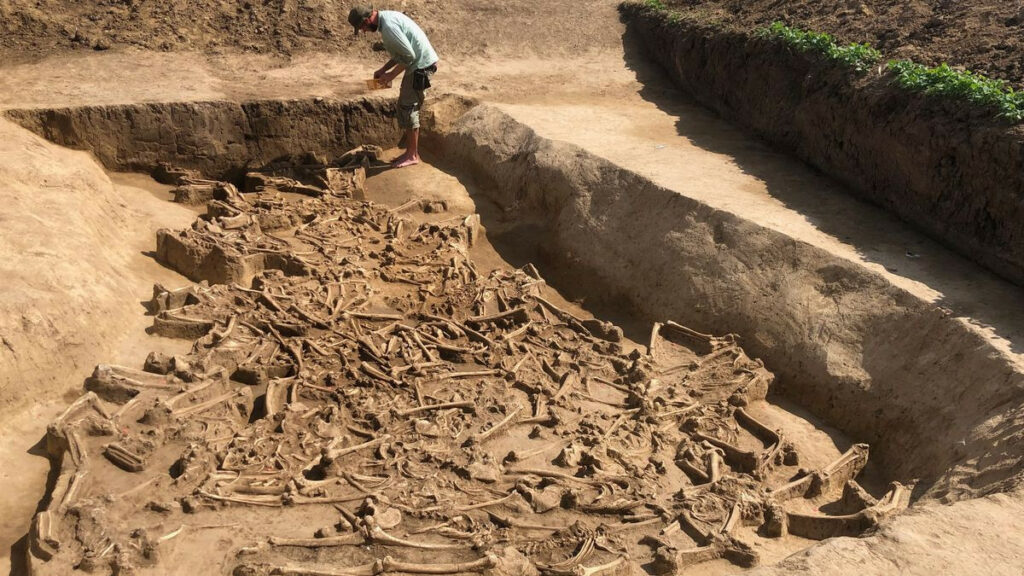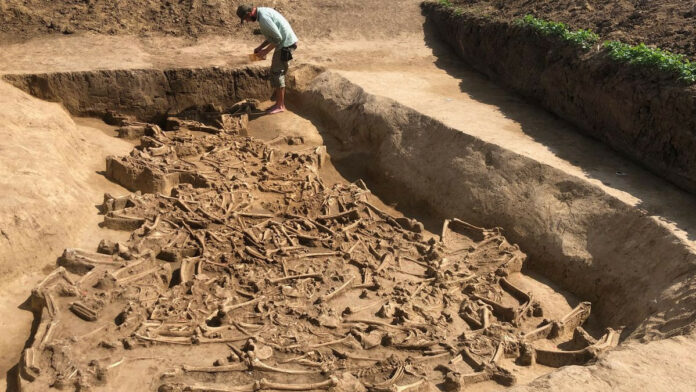6,500-Year-Old French Cemetery Challenges Traditional Gender Roles
The Fleury-sur-Orne Discovery

In the heart of Normandy, France, a perplexing Neolithic burial site dating back 6,500 years has recently come to light, offering intriguing insights into the perception of women in ancient societies. The Fleury-sur-Orne cemetery, part of the Cerny culture, features a series of long barrows – earthen burial mounds extending hundreds of feet, occasionally encircled by wooden palisades that have long since decayed.
A Striking Gender Imbalance
Researchers analyzed the DNA of 14 individuals interred at Fleury-sur-Orne, revealing a startling disparity in gender representation. Among the tested remains, only one was identified as female, buried alongside 13 males. This lone woman’s grave contained “symbolically male” arrows, challenging conventional notions of gender roles in Neolithic communities.

Symbolically Male Status?
The presence of arrows, typically associated with males and hunting in Cerny culture burials, led researchers to hypothesize that the woman may have been considered “symbolically male” to be laid to rest in the same grave. This discovery suggests a more nuanced understanding of gender identity in ancient times.
Contrasting Burial Practices
While the Cerny culture is known for its burial customs across several cemeteries in the Paris Basin region, the Fleury-sur-Orne site stands out. In contrast to the nearly equal representation of men and women in Paris Basin cemeteries, Fleury-sur-Orne was predominantly male, making the presence of the female burial all the more intriguing.

Alison Burns, an archaeologist involved in the study, acknowledged the difficulty in determining the exact status and role of this enigmatic woman, stating, “I don’t think we can speculate anyhow about her status — we don’t have enough elements for that.” Ongoing scientific work, such as isotopic analysis of her remains, may shed light on her diet and geographical origins.
A Window into Ancient Societies
The Fleury-sur-Orne cemetery, spanning an impressive 60 acres, was first discovered in aerial photographs from the 1960s. Since 2014, the French National Institute for Preventive Archaeological Research (Inrap) has conducted extensive excavations at the site, unearthing numerous Neolithic barrow graves and monuments, including Europe’s longest barrow at 1,220 feet (372 meters).
DNA analysis revealed that nearly all the individuals buried in the barrows were unrelated, except for a father and son sharing a grave. This finding suggests a patrilineal community structure, where social authority was passed down through the male lineage, and daughters typically left to live with their mates’ families.
The presence of the female burial with arrowheads challenges traditional interpretations of gender roles within the Cerny culture. While previous studies of Cerny cemeteries in the Paris Basin found male individuals buried with arrows, the woman at Fleury-sur-Orne was interred with similar symbolic artifacts, indicating that her burial in the monumental cemetery held great significance. Researchers postulate that her gender was depicted as masculine, granting her access to this unique burial site.
Chris Fowler, a senior lecturer in later prehistoric archaeology at the University of Newcastle in the United Kingdom, noted that the female buried at Fleury-sur-Orne seemed to be held in the same regard as the men interred there. He also pointed out that the barrow occupants from different lineages were unrelated, raising questions about the social and political dynamics within these communities.
This captivating study offers a glimpse into the intricate dynamics of ancient societies and their perceptions of diverse gender roles. The presence of the female buried with symbolic arrows underscores the complexity of Neolithic communities and the need for further research to deepen our understanding of their history.

